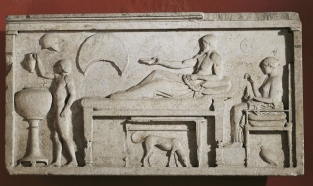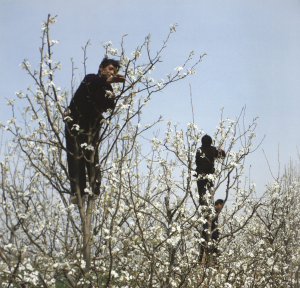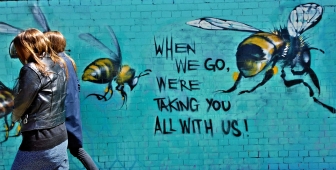Buzzzzzing Through Time
For thousands of years, people wanted the honey and wax from honey bees to make food, candles, and cosmetics. As humans grew more dependent on these items, beekeeping practices changed to increase supplies. These moments in history show the way people have relied on honey bees. This exhibit asks the question: what will the future hold as honey bee populations rapidly decline?
13,000-8,000 BCE: Spain
Early humans climbed ladders to reach nests of wild honey bees. Paleolithic cave paintings from Spain, Africa, Anatolia, Australia, and India show scenes of honey hunting, like this one.
3100-300 BCE: Egypt
Ancient Egyptians collected honeycomb from clay hives and used the honey for food, medicine, and religious rites.
The Egyptians considered the bee so important that they used it in their hieroglyphic writing system. The bee symbolized the king and the land of Egypt.
2100-2000 BCE: Sumer (Southern Iraq)
“Grind to a powder river dust…and [word destroyed], then knead it in water and honey, and let [plain] oil and hot cedar oil be spread over it.”
A cuneiform tablet from Sumer listed the recipe for a prescription.
800 BCE-500 CE: Greece
The ancient Greeks used honey in their food and drink. Cheesecake was a favorite. The poet Archestratus wrote, “Forget all other dessert, there is only one: the Athenian cheesecake with Attica honey from Hymettus.”
Bees were so important to Greek culture, their image was placed on coins to symbolize the goddess Artemis.
610: Middle East
Sura (Chapter) 16 of the Qur’an, titled “The Bees,” described honey bees as female creatures, a scientific improvement over many of the earlier ancient texts.
1025: Bari, Italy
Monks gather bees and honeycomb in this illuminated text. Beekeeping fell out of practice with the collapse of the Roman Empire. Later, the Roman Catholic Church created a demand for wax and candles that revived the beekeeping industry.
1621: Virginia
The Virginia Company of London sent this letter to the Virginia Governor stating that the ship Discovery had been sent with provisions, including beehives, to help the colony survive.
1779: United States
By 1730, the colonists set up over 170,000 hives. Although used primarily to obtain wax, honey bees were also valuable themselves, rivaling the price of sheep and hogs. Beekeping was so profitable and popular within the newly formed United States, the Continental Congress adopted an image of a beehive as the logo for its continental currency.
1785
In his Notes on the State of Virginia, Thomas Jefferson described the importation of honey bees to America. He also explained that Native Americans called them the “white man’s fly” and used them to warn of approaching invaders.
1914-1919
The U.S. Government launched beekeeping programs to aid the rehabilitation of injured veterans returning from World War I.
1941-1945
Beeswax, used for rustproofing World War II military vehicles, became so crucial to the war effort that beekeepers received exemptions from military service.
Despite sugar rations, the Federal Government supplied beekeepers with enough sugar to keep their hives functioning. This allowed them to produce beeswax for the military and honey for consumption.
1984
The international success of the Burt’s Bees line of cosmetics showed that people still crave honey and beeswax, and have found new ways to use them.
1988
To honor the honey bee and the role it has played in the United States, many states adopted it as their official insect and the U.S. Postal Service even created this national stamp.
2006
Scientists discovered the beginnings of Colony Collapse Disorder. Although they cannot attribute a single cause to the rapid decline in honey bee populations, the severity is undeniable.
2009
In an effort to offset the population decline and encourage pollination, Michelle Obama brought honey bees to the White House vegetable garden.
2035: Is This The End?
In the 1980s, the honey bees in the Southern Sichuan Province of China disappeared. Now the people must pollinate their fruit trees by hand. This could be the future for the United States.
Though the causes of Colony Collapse Disorder remain unclear, the consequences are undeniable. Humans have long relied on honey bees to make food, candles, and cosmetics. Beekeepers even adapted their practices to increase honey and wax production. Should the populations continue to decline, people must adjust their daily lives to fit a world in which the honey bees no longer buzz.





















